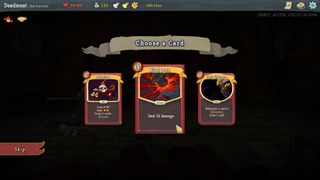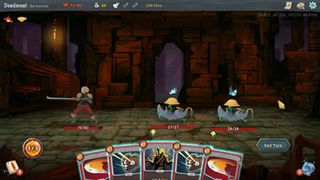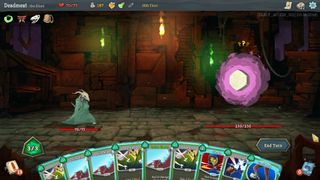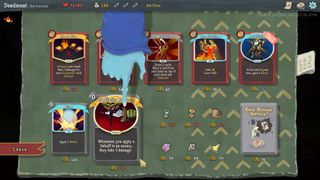Slay the Spire is a brilliant genre mash-up with third-act problems
The roguelike/deckbuilder combo has been a hit on Steam and it's a lot of fun, but the endgame needs a little work.

The joy of a roguelike is cobbling together a winning strategy out of the junk you find lying around on the side of the road—or in this case the side of a corridor in a murdertower full of slime monsters. The joy of a deckbuilding game, whether a physical one like Dominion or a videogame like Hand of Fate, is in building something greater than the sum of its parts. Slay the Spire, which has been in Early Access since November but which we all seem to have become aware of last week when it soared up the Steam charts, is a gorgeous collision of those two joys. I got it last Friday and it basically swallowed my weekend whole.
After each encounter with a monster on my way up the spire, I’m offered three cards to pick from, adding one to my deck. In early runs I eagerly grab a card out of each spread, fattening my deck as much as I can. Later, I’m more judicious, more cautious about assembling a specific strategy.
In Slay the Spire your character is your deck. While some cards are individually more powerful than others, simply accumulating strong cards isn’t enough. Various mechanical themes run through the card sets (there are two characters in the game currently, The Ironclad and The Silent, each with their own set), and they clearly direct you towards building decks that synergize, that combine effects to multiply their impact.

There’s no way to keep a card out of your deck while holding onto it for later, and opportunities to permanently remove cards from your deck are few. So there are trade-offs: you can take a card early that immediately adds dead weight to your deck, but which you hope will become a cornerstone of your strategy later, when you have other pieces of the puzzle to combine with it. Adding improved versions of the basic attack and defense cards will raise the overall power of your deck, but they will also lower your chances of drawing your more important synergistic cards later on.
Changing your deck by a single card feels significant—it’s not a matter of playing the numbers, like making small changes to a Hearthstone or Magic deck.
One card, Fiend Fire, destroys all cards in your hand (removing them from the game until the end of the fight) and deals damage corresponding to the number of cards destroyed. In one of my runs, I had a whole strategy built up around this—draw a ton of cards to fill my hand then unload it all in one enormous attack. Another deck archetype goes the opposite route, using a Power (a card that becomes a persistent buff for the duration of a fight) that deals damage to enemies for every spell played, and then combining that with a mass of free cards to win by a thousand cuts. Though there are two characters, each has three or four distinct deck archetypes.
Each turn you draw five cards, and at the end of the turn you discard your whole hand. This velocity makes it much punchier than most card games, there’s no planning for next turn, or sculpting your hand. There’s no sensation of powerlessness when you draw a hand you know is very weak—it’ll be gone next turn.

As you cycle rapidly through your cards, you’ll see your entire deck pretty much every significant fight. If you have cards that are underpowered or don’t fit with your strategy, they will always show up and be a problem. Changing your deck by a single card feels significant—it’s not a matter of playing the numbers, like making small changes to a Hearthstone or Magic deck.
PC Gamer Newsletter
Sign up to get the best content of the week, and great gaming deals, as picked by the editors.
The deck feels like a dynamic, living thing, both across the strategic layer of the whole game and in individual fights. Deck composition and card-drawing are the heart of a card game: Slay the Spire highlights that heart, making it the center of what your character is and what you can do. Some enemies gum up your deck by inserting useless cards into it, some risk-reward choices give you a benefit in exchange for inserting a dead 'curse' card into your deck.
Combat itself has a push-your-luck quality that suits the roguelike design. You can deal damage to enemies by playing cards, or you can block—blocking means adding temporary hit points to your character, which clear out at the start of your next turn. Monsters show their next move as an icon above them, letting you anticipate what they’ll do and either block or attack accordingly.

This leads to a lot of interesting turns, with tactical decisions that have true strategic ramifications. Ideally, you want to block every attack completely. Healing is hard to come by in this game, and every point of true damage you take could be the start of a spiral that ends your run. But at the same time, playing too conservatively can lead to failure too—slow and steady doesn’t always win the race, as enemies will buff themselves to overwhelm your blocking, or inevitably a bad hand will leave you unable to prevent damage anyway.
I often feel like I reach the final boss just as I’m getting my feet under me in terms of having a deck I like.
Even seemingly simple turns can become a difficult calculation. Is it worth taking one damage this turn to get an attack in? Is it worth spending your first turn setting up your powers for the rest of the fight, and just "face tanking" a big hit for it?
Compounding all this is a panoply of distinct monsters with unique mechanics and behaviors to them. It’s an expansive but well-thought-out bestiary, where no creature feels generic and everything calls for distinct strategies to defeat them.

This is in Early Access, but the visual and interface polish really is there. Card text dynamically changes to reflect modifiers affecting how much damage or block you’re dealing, tooltips are smart and informative, doing a great job of explaining mechanics on the fly without issue. The game’s visual style is a surreal, fun interpretation of high fantasy.
There’s a third character, and thus card set, planned to come out before Early Access ends. But what’s really missing for me is more diversity of challenges and maybe some game balance. The spire is split into three chapters which are always the same—I’d appreciate some more randomness or variety of different zones, and I wish the game was longer, or that I had the option of a longer game with more chapters. I often feel like I reach the final boss just as I’m getting my feet under me in terms of having a deck I like. I want more time for the game to breathe and more of an opportunity to put together truly powerful decks. It feels like those mechanics don’t really have the space they have in a typical roguelike.
And those final fights are often anticlimactic. Many of the fights in chapter three seem like they’re just unfair difficulty spikes. Slay the Spire rests most of its randomness on the positive goodie-bag randomness of loot drops, and on the 'natural' randomness of the card deck. Enemy attacks deal fixed amounts of damage, and enemies have mostly established behavior patterns, so 'bad RNG' is not as much of a frustration as it is in most roguelikes.

This is smart, but it does begin to falter in the third section of the game. Your deck by this point will be very specialized—that’s the only way to beat those later challenges. But many enemies effectively counter certain strategies. Since you can’t avoid a fight or change what’s in your deck, you can feel like you’ve been put into an impossible position. Because the bosses that show up are random, this can get particularly frustrating.
If this genius, chocolate-on-peanut-butter idea of a game has a weakness, it’s in trying to please two very different perspectives on how random a game should be.
One boss, for example, effectively punishes you for playing a lot of cards, ending your turn and becoming more powerful every 12th spell you play. If you’ve assembled the death-by-a-thousand-cuts deck, this becomes a punishing fight, possibly an unwinnable one. Some of these match-up problems are inevitable in a game like this, but the third act feels a lot like a sharp ramp up in difficulty exacerbated by the fact the game overall is a little short.

Everyone has a different level of tolerance for this frustration, and it is a tough balancing act for any game. Devoted fans of roguelikes encounter unfairness and being crushed by randomness as a fact of life, part of the thrill of their genre. But CCG fans often recoil at variance: see the perennial popularity in Magic of decks that are have middling win percentages against every other deck in the metagame; see the player backlash at random effects in Hearthstone cards. If this genius, chocolate-on-peanut-butter idea of a game has a weakness, it’s in trying to please two very different perspectives on how random a game should be.
This is one of those games that very, very clearly knows what it wants to be and how to achieve that. Every mechanic is here for a reason and makes perfect sense in its context. If it needs balance tweaks, or if I wish there was more of it, those are gripes. And gripes aside, I’m not done with Slay the Spire at all, even after it ate my weekend. I’ve still to beat one of the final bosses, after all. I’m pretty sure when I finally nail the perfect iteration of the Ironclad Exhaust deck, I’m going to get there.
Slay the Spire is available on Steam now.
Most Popular


